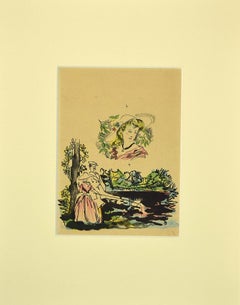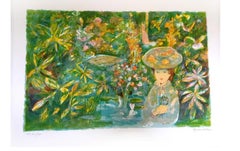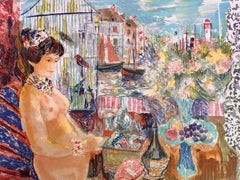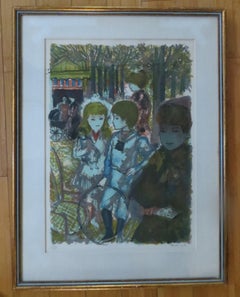Emilio Grau Sala Prints and Multiples
Spanish, 1911-1975
Emilio Grau Sala came from a family of artists. He was born in Barcelona in 1911 and his father, a good cartoonist, had been one of the promoters of the "Salon des Humanistes" and made his exhibitions normally in "Sala Parés", Barcelona.
His first works were exhibited at the Salon des Independents. In the years 1930-33 he had painted under the influence of Cubism, especially that of Torres García. It is from that time a painting of the port of Barcelona, geometric and structural, which completely anticipated what would later be his work. His personality began fully painting watercolors and oils with a certain fantasy character, with a point of decorative instinct and themes full of naivety and grace. Romantic interiors, paddocks, port scenes, sailors, etc.
Grau Sala was essentially a Mediterranean painter, son of post-impressionism and enriched with French painting of the last fifty years. Mediterranean because his work has the color and light of that land.
He understood and assimilated impressionist painting very well, and for that reason he was never subject to the modules of a formulist realism, nor the sexigencias of the forms.
In Paris he found the best environment to give us a fruitful and intense work, because he could use the expressive potential of French art to enrich it.
All this made him a very esteemed artist everywhere where his work was known. He was also very often required to illustrate books and publications in Paris. Also his posters were very successful.
He painted a large number of subjects, but perhaps the theme of horse racing is where you can see in a very clear way the joyful and optimistic life that was lived at that time. In this fabric there is an explosion of juicy and vivid colors full of ingenuity and simplicity in its composition. Only a teacher could turn the complicated into something simple and beautiful. Before this work we feel a deep emotion, the emotion of before starting a horse race. Joy and nervousness at the same time. Especially since it is a direct emotion. There are no intermediaries between our eyes and what the work intends to tell us. This is precisely what seduces and catches us of this painting.
His works can be found in the Museums of the Villa de Paris, L'Ile de France Museum, at the Château de Sceaux, Honfleur Museum, La Rochelle Museum, Barcelona Museum, Tossa de Mar Museum, Philadelphia Museum, Museum of Buenos Aires, etc.
EXHIBITION
Museo de Arte Moderno, Madrid
Galería Muller, Buenos Aires
Dindley Gallery, New York
Outdoor and Autumn Halls, Paris
Galería Charpentier, París
Monique de Groote, París
Sala Parés, Barcelona
Sala Rovira, Barcelona
Sala Syra, Barcelonato
1
2
Overall Width
to
Overall Height
to
1
25
1,208
964
918
830
3
1
2
3
3
3
2
2
1
1
1
1
1
2
1
1
1
3
Artist: Emilio Grau Sala
1961 Original exhibition poster by Grau Sala - The vine and the wine
By Emilio Grau Sala
Located in PARIS, FR
Original poster of exhibition realized in 1961 by Grau Sala.
Exhibition - Alcohol - France
French Contemporary painters at Chateau Lascombes in Margaux
Deniaud Frères - Bordeaux
Category
1960s Emilio Grau Sala Prints and Multiples
Materials
Paper
Fishing in the Lake - Lithograph and Watercolor by Emilio Grau - 1950s
By Emilio Grau Sala
Located in Roma, IT
Fishing in the Lake is an original modern artwork realized in the 1950s by the Italian artist Emilio Grau (Barcelona, 1922 - Paris, 1975).
Original Colored Lithograph refined with watercolors.
Passepartout is included (dimensions: cm 38 x 30).
Mint conditions.
Fishing in the Lake is an excellent and refined work depicting a genre scene in the nature. A couple of figures is on a lake immersend in the greening vegetation. The work has been realized by the Catalan artist Emilio Grau (Barcelona, 1922 - Paris, 1975). He studied at the Escuela de Bellas Artes de Barcelona. With his wife Ángeles Santos Torroella...
Category
1950s Emilio Grau Sala Prints and Multiples
Materials
Watercolor, Lithograph
Emilio Grau Sala - Original Handsigned Lithograph - Ecole de Paris
By Emilio Grau Sala
Located in Collonge Bellerive, Geneve, CH
Emilio Grau Sala
Original Handsigned Lithograph
Dimensions: 76 x 54 cm
Edition: HC XXI/XXX
HandSigned and Numbered
Ecole de Paris au seuil de la mutation des Arts
Sentiers Editions ...
Category
1960s Post-Impressionist Emilio Grau Sala Prints and Multiples
Materials
Lithograph
Related Items
1972 After Ernest Trova 'Deck of 50 cards' Pop Art Blue, Multicolor USA
By Ernest Trova
Located in Brooklyn, NY
Paper Size: 7.5 x 6 inches ( 19.05 x 15.24 cm )
Image Size: 7.5 x 6 inches ( 19.05 x 15.24 cm )
Framed: No
Condition: A: Mint
Additional Details: Vintage first edition 1977 pro...
Category
1970s Emilio Grau Sala Prints and Multiples
Materials
Postcard
$60 Sale Price
20% Off
H 7.5 in W 6 in D 0.1 in
Bat in the meadow. 1982. Paper, linocut, 20x34 cm
By Dainis Rozkalns
Located in Riga, LV
Bat in the meadow. 1982. Paper, linocut, 20x34 cm
imprint size 10x25,5 cm total page size 20x34cm
Dainis Rozkalns (1928 - 2018)
Artist, graphic artist, illustrator of folklore and ...
Category
1980s Folk Art Emilio Grau Sala Prints and Multiples
Materials
Paper, Linocut
$186 Sale Price
20% Off
H 7.88 in W 13.39 in
St. Stephen's Cathedral in Vienna - Hand Colored Cityscape Lithograph
By Luigi Kasimir
Located in Soquel, CA
Detailed and dramatic hand-colored etching by Luigi Kasimir (Austrian, 1881-1962). St. Stephen's cathedral towers above the streets of Vienna, with people going about their daily bus...
Category
1920s Photorealist Emilio Grau Sala Prints and Multiples
Materials
Paper, Watercolor, Lithograph
$1,120 Sale Price
20% Off
H 29.75 in W 23.75 in D 0.75 in
19th century color lithograph figures cemetery willow tree memorial headstone
By Nathaniel Currier
Located in Milwaukee, WI
The present hand-colored lithograph was produced as part of the funeral and mourning culture in the United States during the 19th century. Images like this were popular as ways of remembering loved ones, an alternative to portraiture of the deceased. This lithograph shows a man, woman and child in morning clothes next to an urn-topped stone monument. Behind are additional putto-topped headstones beneath weeping willows, with a steepled church beyond. The monument contains a space where a family could inscribe the name and death dates of a deceased loved one. In this case, it has been inscribed to a young Civil War soldier:
William W. Peabody
Died at Fairfax Seminary, VA
December 18th, 1864
Aged 18 years
The young Mr. Peabody probably died in service for the Union during the American Civil War. Farifax Seminary was a Union hospital and military headquarters in Alexandria, Virginia. The hospital served nearly two thousand soldiers during the war time. Five hundred were also buried on the Seminary's grounds.
13.75 x 9.5 inches, artwork
23 x 19 inches, frame
Published before 1864
Inscribed bottom center "Lith. & Pub. by N. Currier. 2 Spruce St. N.Y."
Framed to conservation standards using 100 percent rag matting and TruVue Conservation Clear glass, housed in a gold gilded moulding.
Nathaniel Currier was a tall introspective man with a melancholy nature. He could captivate people with his piercing stare or charm them with his sparkling blue eyes. Nathaniel was born in Roxbury, Massachusetts on March 27th, 1813, the second of four children. His parents, Nathaniel and Hannah Currier, were distant cousins who lived a humble yet spartan life. When Nathaniel was eight years old, tragedy struck. Nathaniel’s father unexpectedly passed away leaving Nathaniel and his eleven-year-old brother Lorenzo to provide for the family. In addition to their mother, Nathaniel and Lorenzo had to care for six-year-old sister Elizabeth and two-year-old brother Charles. Nathaniel worked a series of odd jobs to support the family, and at fifteen, he started what would become a life-long career when he apprenticed in the Boston lithography shop of William and John Pendleton.
A Bavarian gentleman named Alois Senefelder invented lithography just 30 years prior to young Nat Currier’s apprenticeship. While under the employ of the brothers Pendleton, Nat was taught the art of lithography by the firm’s chief printer, a French national named Dubois, who brought the lithography trade to America.
Lithography involves grinding a piece of limestone flat and smooth then drawing in mirror image on the stone with a special grease pencil. After the image is completed, the stone is etched with a solution of aqua fortis leaving the greased areas in slight relief. Water is then used to wet the stone and greased-ink is rolled onto the raised areas. Since grease and water do not mix, the greased-ink is repelled by the moisture on the stone and clings to the original grease pencil lines. The stone is then placed in a press and used as a printing block to impart black on white images to paper.
In 1833, now twenty-years old and an accomplished lithographer, Nat Currier left Boston and moved to Philadelphia to do contract work for M.E.D. Brown, a noted engraver and printer. With the promise of good money, Currier hired on to help Brown prepare lithographic stones of scientific images for the American Journal of Sciences and Arts. When Nat completed the contract work in 1834, he traveled to New York City to work once again for his mentor John Pendleton, who was now operating his own shop located at 137 Broadway. Soon after the reunion, Pendleton expressed an interest in returning to Boston and offered to sell his print shop to Currier. Young Nat did not have the financial resources to buy the shop, but being the resourceful type he found another local printer by the name of Stodart. Together they bought Pendleton’s business.
The firm ‘Currier & Stodart’ specialized in "job" printing. They produced many different types of printed items, most notably music manuscripts for local publishers. By 1835, Stodart was frustrated that the business was not making enough money and he ended the partnership, taking his investment with him. With little more than some lithographic stones, and a talent for his trade, twenty-two year old Nat Currier set up shop in a temporary office at 1 Wall Street in New York City. He named his new enterprise ‘N. Currier, Lithographer’
Nathaniel continued as a job printer and duplicated everything from music sheets to architectural plans. He experimented with portraits, disaster scenes and memorial prints, and any thing that he could sell to the public from tables in front of his shop. During 1835 he produced a disaster print Ruins of the Planter's Hotel, New Orleans, which fell at two O’clock on the Morning of the 15th of May 1835, burying 50 persons, 40 of whom Escaped with their Lives. The public had a thirst for newsworthy events, and newspapers of the day did not include pictures. By producing this print, Nat gave the public a new way to “see” the news. The print sold reasonably well, an important fact that was not lost on Currier.
Nat met and married Eliza Farnsworth in 1840. He also produced a print that same year titled Awful Conflagration of the Steamboat Lexington in Long Island Sound on Monday Evening, January 18, 1840, by which melancholy occurrence over One Hundred Persons Perished. This print sold out very quickly, and Currier was approached by an enterprising publication who contracted him to print a single sheet addition of their paper, the New York Sun. This single page paper is presumed to be the first illustrated newspaper ever published.
The success of the Lexington print launched his career nationally and put him in a position to finally lift his family up. In 1841, Nat and Eliza had their first child, a son they named Edward West Currier. That same year Nat hired his twenty-one year old brother Charles and taught him the lithography trade, he also hired his artistically inclined brother Lorenzo to travel out west and make sketches of the new frontier as material for future prints. Charles worked for the firm on and off over the years, and invented a new type of lithographic crayon which he patented and named the Crayola. Lorenzo continued selling sketches to Nat for the next few years.
In 1843, Nat and Eliza had a daughter, Eliza West Currier, but tragedy struck in early 1847 when their young daughter died from a prolonged illness. Nat and Eliza were grief stricken, and Eliza, driven by despair, gave up on life and passed away just four months after her daughter’s death.
The subject of Nat Currier’s artwork changed following the death of his wife and daughter, and he produced many memorial prints and sentimental prints during the late 1840s. The memorial prints generally depicted grief stricken families posed by gravestones (the stones were left blank so the purchasers could fill in the names of the dearly departed). The sentimental prints usually depicted idealized portraits of women and children, titled with popular Christian names of the day.
Late in 1847, Nat Currier married Lura Ormsbee, a friend of the family. Lura was a self-sufficient woman, and she immediately set out to help Nat raise six-year-old Edward and get their house in order. In 1849, Lura delivered a son, Walter Black Currier, but fate dealt them a blow when young Walter died one year later. While Nat and Lura were grieving the loss of their new son, word came from San Francisco that Nat’s brother Lorenzo had also passed away from a brief illness. Nat sank deeper into his natural quiet melancholy. Friends stopped by to console the couple, and Lura began to set an extra place at their table for these unexpected guests. She continued this tradition throughout their lives.
In 1852, Charles introduced a friend, James Merritt Ives, to Nat and suggested he hire him as a bookkeeper. Jim Ives was a native New Yorker born in 1824 and raised on the grounds of Bellevue Hospital where his father was employed as superintendent. Jim was a self-trained artist and professional bookkeeper. He was also a plump and jovial man, presenting the exact opposite image of his new boss.
Jim Ives met Charles Currier through Caroline Clark, the object of Jim’s affection. Caroline’s sister Elizabeth was married to Charles, and Caroline was a close friend of the Currier family. Jim eventually proposed marriage to Caroline and solicited an introduction to Nat Currier, through Charles, in hopes of securing a more stable income to support his future wife.
Ives quickly set out to improve and modernize his new employer’s bookkeeping methods. He reorganized the firm’s sizable inventory, and used his artistic skills to streamline the firm’s production methods. By 1857, Nathaniel had become so dependent on Jims’ skills and initiative that he offered him a full partnership in the firm and appointed him general manager. The two men chose the name ‘Currier & Ives’ for the new partnership, and became close friends.
Currier & Ives produced their prints in a building at 33 Spruce Street where they occupied the third, fourth and fifth floors. The third floor was devoted to the hand operated printing presses that were built by Nat's cousin, Cyrus Currier, at his shop Cyrus Currier & Sons in Newark, NJ. The fourth floor found the artists, lithographers and the stone grinders at work. The fifth floor housed the coloring department, and was one of the earliest production lines in the country. The colorists were generally immigrant girls, mostly German, who came to America with some formal artistic training. Each colorist was responsible for adding a single color to a print. As a colorist finished applying their color, the print was passed down the line to the next colorist to add their color. The colorists worked from a master print displayed above their table, which showed where the proper colors were to be placed. At the end of the table was a touch up artist who checked the prints for quality, touching-in areas that may have been missed as it passed down the line. During the Civil War, demand for prints became so great that coloring stencils were developed to speed up production.
Although most Currier & Ives prints were colored in house, some were sent out to contract artists. The rate Currier & Ives paid these artists for coloring work was one dollar per one hundred small folios (a penny a print) and one dollar per one dozen large folios. Currier & Ives also offered uncolored prints to dealers, with instructions (included on the price list) on how to 'prepare the prints for coloring.' In addition, schools could order uncolored prints from the firm’s catalogue to use in their painting classes.
Nathaniel Currier and James Merritt Ives attracted a wide circle of friends during their years in business. Some of their more famous acquaintances included Horace Greeley, Phineas T. Barnum, and the outspoken abolitionists Rev. Henry Ward, and John Greenleaf Whittier (the latter being a cousin of Mr. Currier).
Nat Currier and Jim Ives described their business as "Publishers of Cheap and Popular Pictures" and produced many categories of prints. These included Disaster Scenes, Sentimental Images, Sports, Humor, Hunting Scenes, Politics, Religion, City and Rural Scenes, Trains, Ships, Fire Fighters, Famous Race Horses, Historical Portraits, and just about any other topic that satisfied the general public's taste. In all, the firm produced in excess of 7500 different titles, totaling over one million prints produced from 1835 to 1907.
Nat Currier retired in 1880, and signed over his share of the firm to his son Edward. Nat died eight years later at his summer home 'Lion’s Gate' in Amesbury, Massachusetts. Jim Ives remained active in the firm until his death in 1895, when his share of the firm passed to his eldest son, Chauncey.
In 1902, faced will failing health from the ravages of Tuberculosis, Edward Currier sold his share of the firm to Chauncey Ives...
Category
Mid-19th Century Romantic Emilio Grau Sala Prints and Multiples
Materials
Watercolor, Lithograph
19th century color lithograph watercolor landscape figurative animal print
By Nathaniel Currier
Located in Milwaukee, WI
The present hand-colored lithograph presents the viewer with a hunting scene in a picturesque landscape. In the foreground, a man approaches two partridges as his two pointers prepare to flush them out. Beyond, a white fence draws our eyes to the homestead in the distance. Images like this one show how people in the United States were trying to identify themselves as a new nation in the North American landscape - as separate from their European counterparts but with similar similar and specific wildlife and magesties of nature. It also identifies hunting in this landscape as an American pastime.
9.25 x 12.5 inches, artwork
18.38 x 22 inches, frame
Entitled bottom center "Partridge Shooting...
Category
Mid-19th Century Romantic Emilio Grau Sala Prints and Multiples
Materials
Watercolor, Lithograph
Basquiat Annina Nosei Gallery 1982 (Basquiat anatomy announcement)
By Jean-Michel Basquiat
Located in NEW YORK, NY
Jean-Michel Basquiat, Annina Nosei Gallery, New York, 1982:
Rare Basquiat announcement card published by Annina Nosei Gallery to advertise the release of ‘Basquiat Anatomy’ (a suite ...
Category
1980s Pop Art Emilio Grau Sala Prints and Multiples
Materials
Paper, Lithograph, Offset
SUNBATHERS Signed Lithograph, Women in Bikinis, Sunglasses, Beach, Sailboats
By Robin Morris
Located in Union City, NJ
SUNBATHERS by the woman artist Robin Morris, is an original limited edition lithograph printed using hand lithography techniques on archival Arches paper, 100% acid free. SUNBATHERS depicts a two female sunbathers sitting in their lounge chairs on a sunny day at the beach wearing dark sunglasses, straw sun hats, and snazzy red and purple bikinis...
Category
1980s Contemporary Emilio Grau Sala Prints and Multiples
Materials
Lithograph
TEAR OF TIME (Melting Clock)Signed Lithograph on Arches Paper, Surrealism
By Salvador Dalí
Located in Union City, NJ
TEAR OF TIME (Melting Clock) is a limited edition color lithograph by the Modern master Salvador Dali, after an original Salvador Dali gouache pa...
Category
20th Century Surrealist Emilio Grau Sala Prints and Multiples
Materials
Lithograph
$6,200
H 29.25 in W 21 in
"L'intrus" - Satirical French Illustration - Hand Colored Lithograph
By Gaston Hoffmann
Located in Soquel, CA
Comical illustration by Gaston Hoffmann (French, 1883-1977). A doctor is giving a shot to a female patient, while a nurse tries to prevent a man from barging in.
Pencil signed "G Ho...
Category
1950s Realist Emilio Grau Sala Prints and Multiples
Materials
Paper, Watercolor, Lithograph
$236 Sale Price
20% Off
H 13 in W 18 in D 0.5 in
ROSIGNANO DAWN (DIPTYCH)
By Massimo Vitali
Located in Aventura, FL
Offset lithograph on paper. Each stamped and numbered on verso. Edition of 120. Size: 35.5 x 27.5 inches (each); 35.5 x 55 inches (total).
Artwork is in excellent condition. Certif...
Category
Early 2000s Photorealist Emilio Grau Sala Prints and Multiples
Materials
Lithograph, Offset
GARDEN ROMANCE Signed Lithograph, Black Couple Portrait, Lovers, Flower Garden
By James Denmark
Located in Union City, NJ
GARDEN ROMANCE by the artist James Denmark is an original hand drawn, limited edition lithograph(not a photo reproduction or digital print) printed on archival Somerset paper using t...
Category
1990s Contemporary Emilio Grau Sala Prints and Multiples
Materials
Lithograph
$1,440 Sale Price
20% Off
H 32 in W 21.25 in
Insectes.
By Eugene Alain Seguy
Located in London, GB
SEGUY, E[ugene] A[lain].
Insectes.
Paris, Du Chartre et van Buggenhoudt [1924]
Each print is produced entirely by hand using a unique printing process called pochoir, which was p...
Category
1920s Art Deco Emilio Grau Sala Prints and Multiples
Materials
Paper, Lithograph
Previously Available Items
En El Balcon, original lithograph
By Emilio Grau Sala
Located in Belgrade, MT
Emilio Grau Sala (Spanish, 1911-1975) was born in Barcelona and studied at the School of Fine Arts in his native town, in 1929 he moved to France and became part of the Paris School ...
Category
Mid-20th Century Modern Emilio Grau Sala Prints and Multiples
Materials
Lithograph
Children in a Park color lithograph limited edition by Grau Sala
By Emilio Grau Sala
Located in Pasadena, CA
Emilio Grau-Sala. Barcelona 1911 - Paris 1975. Resettled in France in 1930th. Member of Paris School.
Signed and Numbered in pencil beneath the image.
Edition of 23/180 copies.
Date: Mid-20th century.
Color lithograph on paper.
Museums and Libraries: Two works by Emilio Grau-Sala are in the collection of The Metropolitan Museum of Art, New York. One of his works was honored in 1937 at the Carnegie...
Category
Mid-20th Century Modern Emilio Grau Sala Prints and Multiples
Materials
Paper
H 29 in W 22 in D 1 in
Emilio Grau Sala prints and multiples for sale on 1stDibs.
Find a wide variety of authentic Emilio Grau Sala prints and multiples available for sale on 1stDibs. If you’re browsing the collection of prints and multiples to introduce a pop of color in a neutral corner of your living room or bedroom, you can find work that includes elements of yellow and other colors. You can also browse by medium to find art by Emilio Grau Sala in lithograph, paper, paint and more. Much of the original work by this artist or collective was created during the 20th century and is mostly associated with the modern style. Not every interior allows for large Emilio Grau Sala prints and multiples, so small editions measuring 6 inches across are available. Customers who are interested in this artist might also find the work of Miguel Ibarz Roca, Guy Bardone, and John Edward Costigan. Emilio Grau Sala prints and multiples prices can differ depending upon medium, time period and other attributes. On 1stDibs, the price for these items starts at $77 and tops out at $1,621, while the average work can sell for $1,112.





